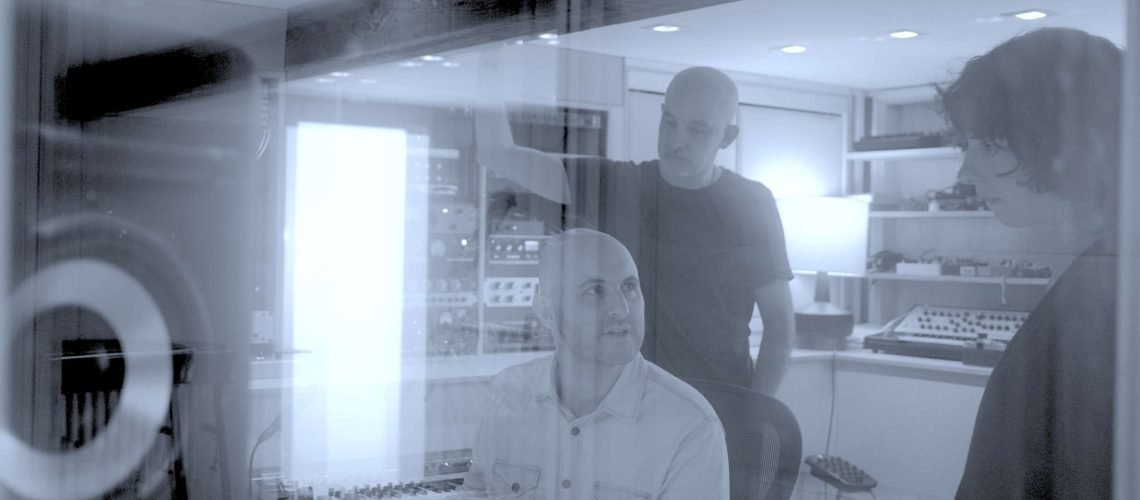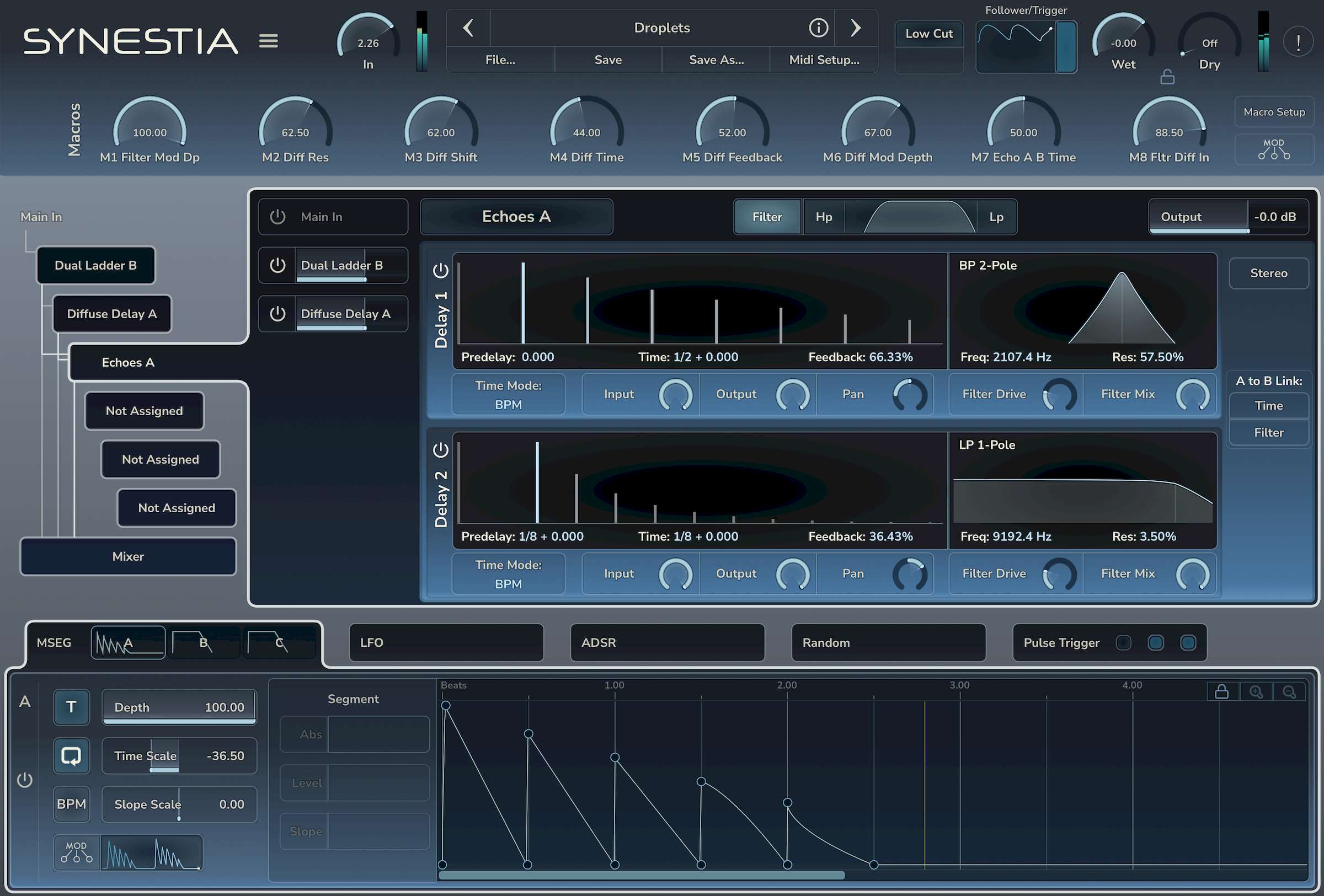“Highlighting inconsistencies”: when it came time to transcribe Taylor Deupree’s seminal 2002 electronic drone album Sti.il for acoustic instruments, everything from technical software details to how we think about music and physical artifacts came into play.
David Abravanel speaks with Taylor Deupree and arranger/producer Joseph Branciforte about the process behind the project – and its deeper significance.

L-R: Joseph Branciforte (seated), Taylor Deupree, & Madison Greenstone
When electronic instruments and effects first appeared in popular music, it was largely a game of imitation of acoustic instruments – loose playing with the modwheel on a synth bass to get a more varying “humanized” timbre, a Mellotron and its tape loops in place of session musician or choir, a rudimentary drum machine often joining a few acoustic percussion instruments to fill things out.
Give any idea in art or culture long enough, and the snake eats its tail – in the past couple of decades, we’ve seen the novel challenge of reinterpreting (or even just matching) music composed with sequencers and computers via human players: from Alarm Will Sound to Pink Freud to Squarepusher’s Shobaleader One or Múm and the Kronos Quartet. Often, the challenge – and perhaps draw – is largely in the complexity of the phrases.
But what about electronic music that focuses on small evolutions over long periods of time? How well can a horn player repeat the same phrase for 20 minutes? It’s in this frame that we find electronic musician and 12k label founder Taylor Deupree’s classic 2002 album Stil., and composer Joseph Branciforte’s new acoustic reinterpretation of the album, Sti.ll. Available in the expected formats (digital, vinyl), and as a deluxe hardcover book edition, Sti.ll is the latest in the FOLIO series from Branciforte’s label Greyfade.
Joseph and Taylor were kind enough to share some thoughts on recording, instrumentation, the physical artifacts we associate with music, and much more.
How did the idea come together to transcribe Stil. for acoustic instruments?
Taylor Deupree: After I tried to create it myself, briefly, I knew it would have to be done on a much deeper level with someone much more knowledgeable about such things than I am. It was pretty amazing to see how detailed Joe went… far beyond what I imagined. I wanted to capture the essence of the original, complete with the incidental sounds and glitches, but all with microphones, all acoustically. Joe was able to notate and communicate these ideas to the players. For example, we’d use breath and fingering techniques with the clarinet to create noise and scratching sounds. A flute would provide high-frequency beeps. I had these ideas in my head but didn’t know how to execute them or find the right players to do it.

Joseph Branciforte: Taylor approached me with the idea in 2022. He had heard my acoustic arrangements of Kenneth Kirschner’s electronic works from our 2021 collaborative recording, From The Machine, Vol. 1. He thought that I would be the right person to arrange and produce an acoustic adaptation of Stil.
Once we were already well into the process, I asked Taylor if he’d consider a joint physical release on Greyfade and 12k, with Greyfade releasing the album in FOLIO form and 12k as a double vinyl LP.
Stepping back for a moment, what were the ideas behind the original Stil.?
Taylor: Stil. was a follow-up to an album that came out the year prior called Occur. Where Occur was inspired by the transitory nature of sounds around us, specifically influenced by the life of the city I lived in (Brooklyn). It was my “musique concrete” work where the sounds I was using were almost like found sounds, but they were created, synthesized… not field recordings or anything naturally occurring. Stil. was created to be the opposite of this, exploring themes of repetition and stillness. Heavily inspired by the photographic work of Hiroshi Sugimoto, Stil. was about implied movement through subtle change and layers of asynchronous loops. Highly repetitive on the surface, but ever-shifting underneath.
Heavily inspired by the photographic work of Hiroshi Sugimoto, Stil. was about implied movement through subtle change and layers of asynchronous loops. Highly repetitive on the surface, but ever-shifting underneath.
Getting technical: how did you create and process the sounds on the original Stil.?
Taylor: The most important instruments that I can remember were the Nord Modular and NI’s Reaktor as sound sources and, in the case of Reaktor, granular looping. Digital Performer was my DAW at the time and was very much responsible for the creating and layering of the asynchronous loops and, of course, ultimately, the compositions. DP has a feature that Pro Tools still can’t do, which is the ability to have every track in a session contain their own, independent loops. (in Pro Tools (my current DAW) you can only loop the whole session as one and the loop isn’t permanent). You can assign loop durations and lock them in as characteristics of each track, so every track in a session can be looping completely asynchronously against the others. This was very much the way I composed.

Audio Ease’s PeriScope EQ – an essential part of the sound of Stil.
Also, around that time, nearly everything I was doing was somehow or another affected by Audio Ease’s PeriScope plug-in. It was the 30- (36?) band graphic EQ with the ability to cut a band to negative infinity, to completely silence it. This allowed me to create extreme bandpass filters and really isolate small sections of a sound. I could take a big full sound and turn it into a small buzz. It was PeriScope’s incredibly steep and numerous filters, coupled with the cut to negative-infinity, that set it apart from everything else, and is still unequaled today. Unfortunately, PeriScope doesn’t exist anymore.
The Nord Modular was one of my main sound sources, and perhaps a Waldorf Microwave XT. I used the Nord for many things, from simple tones to complex generative patches. Reaktor did the granulation and loop manipulation.
Mixing would have been in the box at that point, in [MOTU] Digital Performer, and simply bounced out.
Stil. is largely made of either synthesized sound or manipulated recordings, primarily drones and phrases that evolve slowly in minimalist ways. Getting the same note to sound the same twice on an acoustic instrument is notoriously challenging. Did the repetitive nature of Stil. inform your idea to transcribe it for acoustic instruments?
Joseph: I think Taylor’s primary motivation for undertaking the acoustic recreation was to highlight these kinds of acoustic inconsistencies. Since the material on the album is so repetitive—with a single short loop often repeating for 10 minutes or more—the variation in the acoustic sounds almost takes the place of traditional musical “development.” Thus, the small changes in timbre, dynamics, and phrasing became a main point of interest for us in these arrangements.

Taylor, What was your role with Joseph during the transcription, recording, and editing of Sti.ll?
Taylor: Joe was totally responsible for the transcription, as that’s his area of expertise. I was 100% confident in him executing that properly. He handled all of the engineering and recording, and I would attend sessions, make suggestions, and hear what was going on.
The recording was quite straightforward. We wanted to utilize the best possible signal path. Beautiful microphones and preamps, captured with little to no EQ or compression. There were no effects used, save a little reverb here and there in the final mix. Joe is a wonderful engineer so he has the ability (and the gear) to make this all happen.
For the editing, Joe set up the initial Pro Tools sessions and mixes. They got quite extensive… and we worked together to sculpt the best arrangement that suited the new compositions the best. We allowed ourselves to veer from the originals if we needed to because we were dealing with an entirely new set of instrumentation and basically from a blank slate. We did the final mixes at my studio through the console and I mastered it here as well.

Joseph Branciforte mixing Sti.ll
Joseph, how did you come to decide which acoustic instruments to use in your transcriptions? Can you walk me through which instruments are used on each of the four tracks?
Joseph: The instrumentation on each track was often a combination of top-down thinking (i.e. “we think these instruments would be interesting”) and bottom-up (i.e. “this sound or register can only really be achieved by a certain instrument” or “we know the following people who are available on the following dates”). In this way, the arrangements evolved organically, in response to Taylor’s initial suggestions, my own orchestration ideas, and a roster of players with whom I had worked closely on previous projects.
“Temper” was the first arrangement I did. It was for 13 clarinets (B-flat, bass, and contrabass) plus Meinl spark shaker. In our initial discussions about the project, Taylor mentioned wanting to use clarinets. While I didn’t have a ton of experience writing for that instrument, I was able to workshop the piece with a wonderful clarinetist, Madison Greenstone, who gave me a sense of the wide range of sounds and extended techniques that were possible. She ended up recording all 13 clarinet parts, plus the shaker part, herself, as a series of overdubs.
Since clarinet had worked so well for “Temper”, I arranged “Snow/Sand” for clarinets with the addition of vibraphone, cello, and percussion. The percussion parts consisted of snare drum played with brushes, sheets of paper played with brushes, and a collection of small bells and objects.

Joseph Branciforte’s B-flat clarinet score for “Temper.”
recorded the title track “Stil.” myself on vibraphone and bass drum. The arrangement was for 12 layers of vibraphone, each with subtle changes in mallet weight, playing speed, motor speed, and mic placement over the course of its 20-minute duration. Although the 12 pitches themselves never change, the texture is constantly shifting in a myriad of other ways.
The final track, “Recur”, was easily the album’s most elaborate arrangement. I scored it for five layers of acoustic guitar, six layers of cello, five layers of flute, upright bass, lap harp, and percussion. I relied on constantly shifting meters and overlapping tempi to capture the rhythmic details of the original piece, which required a lot of time transcribing and a considerable amount of pre-production work to pull off in the final recording.
The original Stil. makes extensive use of looping and granular synthesis. Did you utilize looping or other digital editing techniques for Sti.ll?
Joseph: The pieces were all recorded as a series of overdubs at my studio, following click tracks—so not an ensemble recording per se—but there was no use of digital looping or repetition of material in the DAW. Our two cardinal rules in the making of Sti.ll were: a) it must all be played—even if a phrase repeats 90 times, it has to be performed 90 times, with no looping in Pro Tools—and b) it must all be captured with a microphone—no electronic instruments or effects. Even the fade-outs were done live by the players rather than electronically.
Often, it wasn’t sonically desirable (or physically possible) for a performer to play for 20 minutes straight, so we’d break it up into a few shorter takes and then edit them together into a composite, being careful not to reuse material. So, where editing was done, it was always in service of the idea of creating a long, unbroken take with no literal repetitions.

The FOLIO edition of Sti.ll.
What are your thoughts on something as lushly packaged as the FOLIO series in an era where streaming – with minimal contextual information included – has become the dominant means of interaction with recorded music?
Joseph: Greyfade’s FOLIO music release format is an attempt to re-imagine the physical music release experience in 2024.
It’s a 6.5 x 8” linen hardcover book that—in addition to a high-resolution digital download or private stream of the album itself—includes long form essays, musical scores, reflections on process and technology from the album’s participants, studio photography, and more.
It represents what we believe to be the best of both the physical and digital worlds: a substantive and beautiful physical object alongside a high-resolution digital version of the album, exactly as the artists created it in the studio, without any third-party mediation, transcoding, advertising, or other such interventions between artist and listener.

Taylor: Physical products are more important than ever and continually harder and harder to produce, sell and ship. Similar to over-clogged plug-in libraries stuffed with forgotten effects, streaming libraries suffer from “more isn’t better.” When you have everything, what is special? what is meaningful? A physical music release, especially something as fully realized as a Greyfade FOLIO takes effort to purchase and consume, and when you put effort into something it has more meaning to you.
I think we’ve seen this with the resurgence in vinyl. People realizing there is something special about taking a pause to find a record on your shelf, put it on the turntable and commit 20 or 40 minutes to listening to it. It means something, it’s an intentional act that carries weight. The streaming alternative feeds waning attention spans, choice paralysis, and possibly caring less about what you’re listening to because it’s just a tiny speck in the infinity of music.

Sti.ll is available as a digital download, on vinyl, or in the FOLIO edition. Will it be put on streaming services?
Joseph: Since I started Greyfade in 2019, we’ve made a conscious decision to keep the label’s releases off of streaming services. For those who are interested in the full reasoning, I’ve written a bit about it on Greyfade’s website, but the short version is that I don’t believe that these streaming platforms currently offer a model for engaged listening and a sustainable economic model for creators.
Until artists start exercising control over their own work and offering listeners alternatives to the big streaming platforms, we will all be at the mercy of whatever terms these companies dictate for the entire musical landscape.
The intention is not to be didactic or to tell people how they should listen to music. It’s more akin to the way that the organic food or farmer’s market movements created demand for a higher quality product and more direct relationships between producers and consumers in the food industry a few decades ago. I think a similar change is possible in the music industry. This only occurs if listeners are educated about the consequences of always opting for the cheapest and most convenient option—and are offered a compelling alternative.
Taylor: It’s also a shame that online music, whether it’s purchased or streamed, did away with the liner notes. Production credits, thank-you lists, back stories, are gone. You can often find them on the label website, if you care to look, but to the casual listener, and especially the new generation of listeners, what went into the actual creation of the music doesn’t become part of the story. Music becomes generic; the way for AI is paved.
What went into the actual creation of the music doesn’t become part of the story. Music becomes generic; the way for AI is paved.
As a label owner, however, I largely have to follow along. Yes, I can still make physical products, which I always have for nearly every release, even if they don’t sell, I feel strongly about it. But I’m also not going to protest too hard and remove all of my music from streaming services because I can see that the public has spoken and this is how they prefer to take in music. We have to ride the wave and be flexible enough to adapt, whether we like it or not. We can stick our heads up every now and then with a beautifully packaged release for those who care to take notice, but ultimately we are at the whim of the listening public.
Sti.ll is released May 17, 2024 on Greyfade and 12k. Find the album on Bandcamp and in the Greyfade shop.




